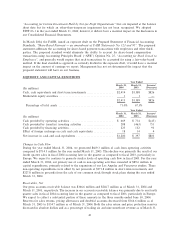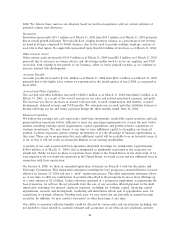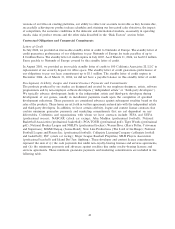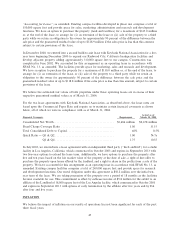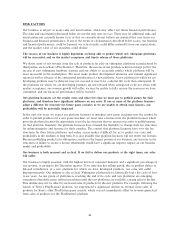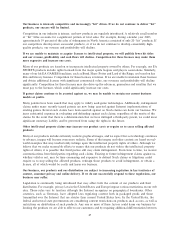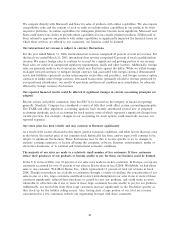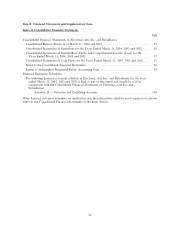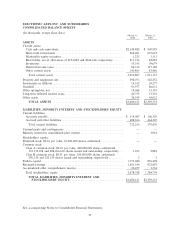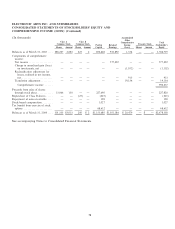Electronic Arts 2004 Annual Report Download - page 64
Download and view the complete annual report
Please find page 64 of the 2004 Electronic Arts annual report below. You can navigate through the pages in the report by either clicking on the pages listed below, or by using the keyword search tool below to find specific information within the annual report.We compete directly with Microsoft and Sony for sales of products with online capabilities. We also require
compatibility code and the consent of each in order to include online capabilities in our products for their
respective platforms. As online capabilities for videogame platforms become more signiÑcant, Microsoft and
Sony could restrict our ability to provide online capabilities for our console platform products. If Microsoft or
Sony refused to approve our products with online capabilities or signiÑcantly impacted the Ñnancial terms on
which these services are oÅered to our customers, our business could be harmed.
Our international net revenue is subject to currency Öuctuations.
For the year ended March 31, 2004, international net revenue comprised 45 percent of total net revenue. For
the Ñscal year ended March 31, 2003, international net revenue comprised 42 percent of total consolidated net
revenue. We expect foreign sales to continue to account for a signiÑcant and growing portion of our revenue.
Such sales are subject to unexpected regulatory requirements, tariÅs and other barriers. Additionally, foreign
sales are primarily made in local currencies, which may Öuctuate against the dollar. While we utilize foreign
exchange forward contracts to mitigate foreign currency risk associated with foreign currency denominated
assets and liabilities (primarily certain intercompany receivables and payables), and foreign currency option
contracts to hedge some foreign currency forecasted transactions (primarily related to revenue generated by
our operational subsidiaries), our results of operations and Ñnancial condition may, nonetheless, be adversely
aÅected by foreign currency Öuctuations.
Our reported Ñnancial results could be aÅected if signiÑcant changes in current accounting principles are
adopted.
Recent actions and public comments from the SEC have focused on the integrity of Ñnancial reporting
generally. Similarly, Congress has considered a variety of bills that could aÅect certain accounting principles.
The FASB and other regulatory accounting agencies have recently introduced several new or proposed
accounting standards, such as accounting for stock options, some of which represent a signiÑcant change from
current practices. For example, changes in our accounting for stock options could materially increase our
reported expenses.
Our stock price has been volatile and may continue to Öuctuate signiÑcantly.
As a result of the factors discussed in this report, general economic conditions, and other factors that may arise
in the future, the market price of our common stock historically has been, and we expect will continue to be,
subject to signiÑcant Öuctuations. These Öuctuations may be due to factors speciÑc to us, to changes in
analysts' earnings estimates, to factors aÅecting the computer, software, Internet, entertainment, media or
electronics businesses, or to national and international economic conditions.
The majority of our sales are made to a relatively small number of key customers. If these customers
reduce their purchases of our products or become unable to pay for them, our business could be harmed.
In the U.S. in Ñscal 2004, over 70 percent of our sales were made to six key customers. In Europe, our top ten
customers accounted for over 35 percent of our sales in that territory in Ñscal 2004. Worldwide, we had direct
sales to one customer, Wal-Mart Stores, Inc., which represented 13 percent of total net revenue in Ñscal
2004. Though our products are available to consumers through a variety of retailers, the concentration of our
sales in one, or a few, large customers could lead to short-term disruption in our sales if one or more of these
customers signiÑcantly reduced their purchases or ceased to carry our products, and could make us more
vulnerable to collection risk if one or more of these large customers became unable to pay for our products.
Additionally, our receivables from these large customers increase signiÑcantly in the December quarter as
they stock up for the holiday selling season. Also, having such a large portion of our total net revenue
concentrated in a few customers reduces our negotiating leverage with these customers.
49




